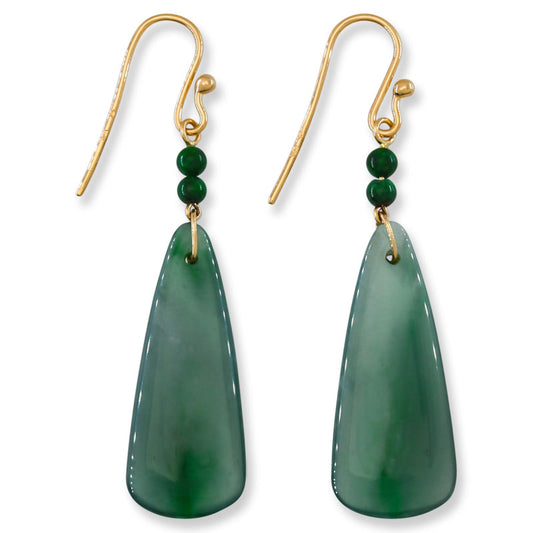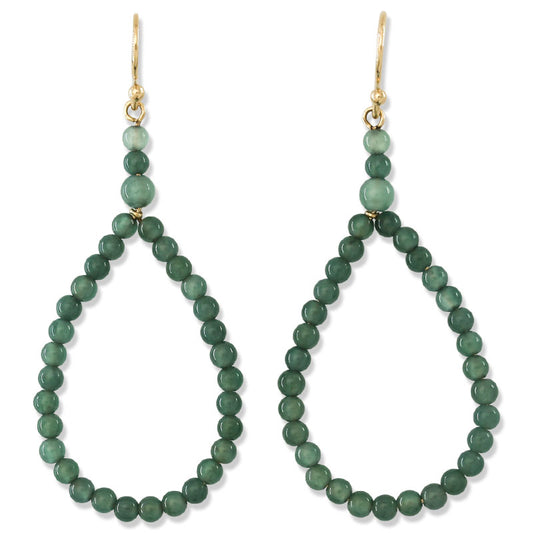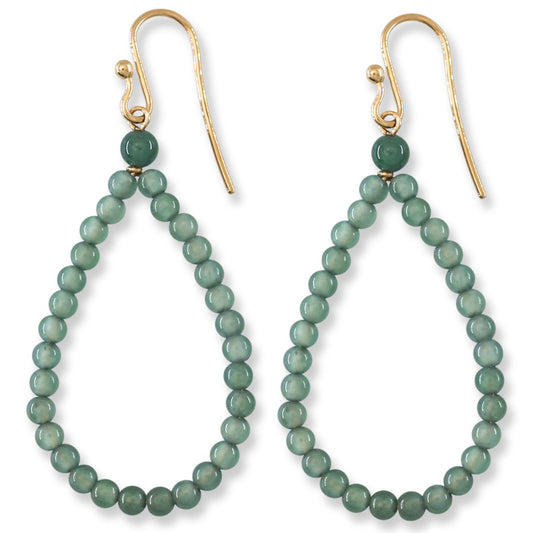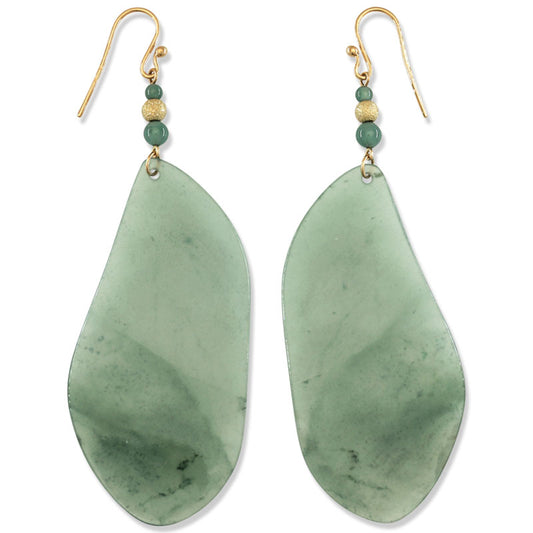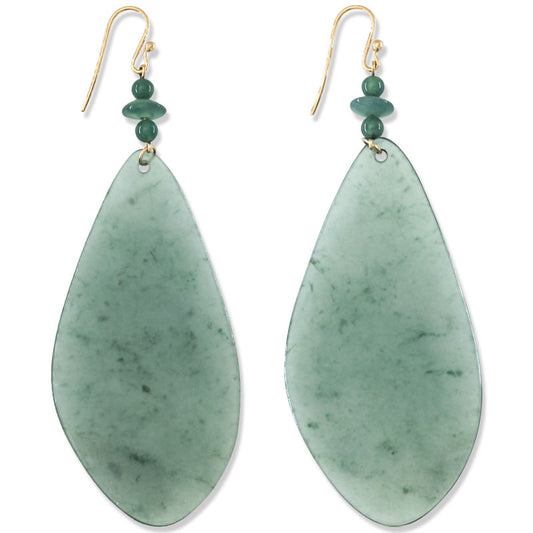Collection: Shop Guatemalan Jadeite Jade Jewelry

The Two Jades
Jade is a name given to two distinct gemstones: Nephrite Jade and Jadeite Jade (also called Fei Cui). Natural, untreated jadeite is known as ‘A Jade.’
Most jadeite jade in today’s market comes from Myanmar, but Guatemala is considered the second most significant jadeite-producing country. However, the majority of jadeite available in the U.S. is still Burmese in origin.
Jade in Ancient Mesoamerica
At least seven different Mesoamerican civilizations revered and used jadeite jade, including the Olmec, Maya, and Aztec. It was highly valued and used for:
- Tools and weapons
- Celts (ritual axes)
- Religious and burial artifacts
- Jewelry
- Dental implants
A Jade Lost to History
The Spanish Conquest in the 1500s abruptly ended the jade trade in Mesoamerica, and for centuries, Guatemala's jade deposits were forgotten.
The Modern Era of Guatemalan Jade:
- 1904-1909: Edward H. Thompson dredged the Sacred Cenote in Chichen Itza, unearthing a trove of jade artifacts that revealed connections to the Olmec civilization.
- 1954: Geologist William Foshag published findings linking pre-Columbian jade artifacts to Guatemala.
- 1973: American jade hunter Jay Ridinger and archaeologist Mary Lou Johnson fell in love while searching for jade in Guatemala. Their discovery led to the founding of Jade Maya, the country's first major jade business, still in operation today.
- 1999-2001: Russell Seitz uncovered a significant source of translucent blue jadeite jade in Guatemala.
Mason-Kay Jade, the leading supplier of natural jadeite jade (also called 'fei cui') in the U.S., is currently a major supplier of Guatemalan jadeite jade to American retail jewelry stores.
Guatemalan Jade Colors and Characteristics
Guatemalan jadeite jade comes in a diverse palette, including:
- Blue
- Blue-green
- Green
- Lavender
- White
- Black
- Yellow
- Red
Fine Guatemalan jade is translucent with a vivid, true green color. High-quality green jadeite jade (also called 'fei cui') is particularly rare because much of the rough material is fractured or has only thin veins of green running through blue or blue-green boulders.
Guatemalan jadeite jade is often recognizable by its characteristic grey-blue-green hue, with albite ‘snowflake’ inclusions and mica inclusions.
Blue Jade Explained
While nephrite jade is more common than jadeite jade (also called fei cui), high-quality specimens of blue nephrite jade are rare. Blue nephrite jade is mainly sourced from California and Russia, but is not commercially significant on the world market.
Blue jadeite jade from Myanmar does exist but is rarely seen in the American market. Most blue jadeite available in the U.S. today comes from Guatemala.
About Mason-Kay
Established in 1976, Mason-Kay Jade is the premier wholesale supplier of natural jadeite jade in the U.S.
Owner Jeff Mason, G.G., is an expert in jade testing and valuation, offering services to both the trade and the public. While Mason-Kay carries some nephrite jade and Guatemalan jadeite jade, our primary inventory consists of gem-quality Burmese jadeite—available as bangles, beads, cabochons, and mounted jewelry designed by Kristina Mason.
-
GREEN JADEITE JADE FLAT CONTINUOUS BAND RING SIZE 8 UPC #395220
Regular price $550.00 USDRegular priceUnit price / per -
GREEN JADEITE JADE FLAT CONTINUOUS BAND RING SIZE 8.5 UPC #395213
Regular price $370.00 USDRegular priceUnit price / per -
GREEN JADEITE JADE FLAT CONTINUOUS BAND RING SIZE 8.25 UPC #395190
Regular price $190.00 USDRegular priceUnit price / per -
BLUE GREEN JADEITE JADE ADJUSTABLE BEAD BRACELET UPC #393462
Regular price $1,680.00 USDRegular priceUnit price / per -
Blue Green Jadeite Jade Adjustable Bead Bracelet | UPC #392519
Regular price $810.00 USDRegular priceUnit price / per -
14K Yellow Gold Blue Green Jadeite Jade Freeform Pendant | Guatemalan Jade | UPC #394476
Regular price $330.00 USDRegular priceUnit price / per -
14K Yellow Gold Blue Green Jadeite Jade Freeform Pendant | Guatemalan Jade | UPC #394452
Regular price $340.00 USDRegular priceUnit price / per -
14K YELLOW GOLD BLUE GREEN JADEITE JADE DROP EARRING UPC #396036
Regular price $2,700.00 USDRegular priceUnit price / per -
14K YELLOW GOLD GREEN JADEITE JADE BEAD HOOP EARRING UPC #396265
Regular price $1,190.00 USDRegular priceUnit price / per -
14K YELLOW GOLD GREEN JADEITE JADE BEAD HOOP EARRING UPC #395862
Regular price $1,110.00 USDRegular priceUnit price / per -
14K YELLOW GOLD TRANSLUCENT GREEN JADEITE JADE DROP EARRING UPC #396869
Regular price $1,380.00 USDRegular priceUnit price / per -
14K YELLOW GOLD TRANSLUCENT GREEN JADEITE JADE DROP EARRING UPC #396975
Regular price $1,160.00 USDRegular priceUnit price / per -
14K YELLOW GOLD GREEN JADEITE JADE TRANSLUCENT DROP EARRING UPC #396883
Regular price $1,170.00 USDRegular priceUnit price / per -
Blue Green Guatemalan Jadeite Jade Half Round Bangle | Size 60.5MM | UPC #355699
Regular price $3,150.00 USDRegular priceUnit price / per -
BLUE GREEN JADEITE JADE ADJUSTABLE BEAD NECKLACE UPC #396791
Regular price $3,990.00 USDRegular priceUnit price / per -
Blue Jade Bangle Bracelet | Blue-Green Jadeite Jade Cylindrical Bangle Size 60.8MM | UPC #168886
Regular price $1,690.00 USDRegular priceUnit price / per








